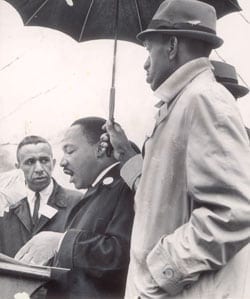
“Designated Driver.” This was my title when the Rev. Dr. Martin Luther King Jr. arrived in Boston in April 1965. On that cloudy, intermittently rainy day, the designated driver was later assigned to be an “umbrella man,” shielding Dr. King as much from the elements as the possibility of a lurking assassin within range of Boston Common, where the civil rights icon would address an estimated crowd of 22,000 supporters.
For a current generation witnessing an anemic economic recovery, Congressional gridlock, Occupy Boston and unpredictable climate changes, it is instructive to revisit the excitement and challenges facing the spring 1965 march in Boston.
At that time, the Ministerial Alliance of Boston was addressing issues of diversity, race, education, employment and economics. But school desegregation would be the major focus of the march and the subsequent April 23 speech on Boston Common.
The Rev. Dr. Michael E. Haynes, Minister Emeritus of the Twelfth Baptist Church, initiated this adventure. Rev. Haynes asked both James Loving Jr. and me for assistance, as Dr. King and Rev. Ralph Abernathy would be coming to Boston. I recall Dr. Hayne visiting my employer, Carroll’s Cut Rate in Roxbury, with a plan.
I was to be given the assignment of lead driver for Dr. King; James, the lead driver for Dr. Abernathy. The first to pull out en route to any destination would be the decoy for safety, so that no one would know which limo carried Dr. King. Both of us were in our early 20s, crazy and excited at the prospect of driving without complications, speeding everywhere in the drive of a lifetime.
James and I were directed onto the tarmac at Logan International Airport. Having picked up our passengers, we were to proceed through the Sumner Tunnel into Boston at speeds in excess of 65 mph — a major adrenalin rush! Both of us were instructed to follow police directives for speed was of the utmost importance, which made us even more excited viewing our motorcycle escort. Yet we were deeply aware of being part of history in the making.
Nineteen sixty-five was the year when Dr. King also led the Selma-Montgomery voting rights march. It was the year of escalating warfare in South Vietnam, the death of Malcolm X, a massive power failure in the northeastern U.S. and Canada.
Additionally, Patricia Harris became the first African American ambassador and U.S. Marines landed in the Dominican Republic. Meanwhile, in the racially volatile local environment, the civil rights movement had arrived, no longer confined to the South, but now here in America’s “Cradle of Liberty.”
Despite the passage of years, the agenda remains crystal clear: the meeting with Mayor John F. Collins at City Hall; an address at the Statehouse; demonstrations at the Campbell and Sherwin Schools in Roxbury. Another demonstration was held at the Boston Public Schools headquarters; another speech at Temple Israel on Longwood Avenue; and a visit with Cardinal Richard Cushing were also on the hectic schedule.
And there was the march — a determined and resolute crowd (“A Mile of Marchers” declared the headline in The Boston Globe) walking with solemn deliberation from the William E. Carter playground in lower Roxbury, down Columbus Avenue to the Parkman Bandstand on Boston Common.
But my most memorable moment, however, remains the very uncommon speech I witnessed that day in the heart of a divided city. After parking the limos under close police scrutiny, a light rain began to fall, sprinkling the crowd, perhaps an unexpected benediction. I pulled out an umbrella to cover myself, realizing moments later that the priority should be shielding Dr. King, who was calmly taking a few notes. Introducing Dr. King, Dr. Abernathy reminded in the throng: “We may live down South, but you live up South!” Delivering a speech from memory, Dr. King thanked Boston for its hospitality and keeping him from harm.
With the Rev. Gilbert Cardwell of Union United Methodist Church on Dr. King’s left, and I on the right, we stood impassively, absorbing Martin Luther King’s eloquence; his plea for the demonstrators to be agents of change instead of leading lives of passive acceptance within an accelerating worldwide struggle for equal rights and dignity. “Now is the time to make real the promise of democracy,” King declared, “Now is the time!”
Nearly a half-century later, one is moved to reflect on much of the complacency and hedonism all around us. What a contrast to the ambience of 1965, when access to and the pursuit of education were uppermost in the minds of so many Roxbury residents. Today, access to easy credit, the warp speed of digital communications, social stratification and self-gratification mark some of the preoccupations of our times.
These present no fewer challenges to social consciousness and racial harmony than the prejudice, segregation, discrimination and fear physically palpable back in the Boston of the ’60s.
Hasan Abdullah Sharif, formerly known as Arnold M. Walker, has been affiliated with Roxbury Community College for more than a decade, having served as an instructor and currently as a senior counselor with the Upward Bound program.






